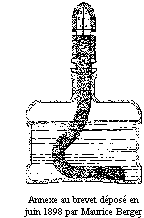In
the 1800's, modern antimicrobial agents were unknown. In the
1820's, two European chemists discovered the concept of oxidizing
alcohols, using a precious metal catalytic device. During
this time period, hospitals began using catalytic diffusers to
reduce problems related to infections. Today, we know that
what was actually happening was these diffusers used catalytic
alcohol combustion to remove and inactivate particles in the air.
The removal or inactivation of these infectious agents from the
air helped save lives, and the use of these diffusion systems grew
rapidly. As a result, many companies began making these
types of products. device. During
this time period, hospitals began using catalytic diffusers to
reduce problems related to infections. Today, we know that
what was actually happening was these diffusers used catalytic
alcohol combustion to remove and inactivate particles in the air.
The removal or inactivation of these infectious agents from the
air helped save lives, and the use of these diffusion systems grew
rapidly. As a result, many companies began making these
types of products.
While this technology remained in use primarily in Europe,
World War II put virtually every company that produced these
types of products out of business because of the scarcity of
supplies. While companies went out of business, the
technology to remove particles and unwanted chemicals from the
air remained valid.
Using modern analytical techniques, today we better understand
how catalytic diffusion lamps work. In the case of the
patent pending Lamp Aire lamp, the catalytic burner diffusion
lamp acts in a three prong manner. First, the Lamp Aire
diffuser evaporates therapeutic essential oils directly into the
air. These essential oils have various effects, depending
on which fuel is used. The effects are directly related to
the response of the user in the presence of the lamp. Secondly,
the Lamp Aire diffuser undergoes the same catalytic combustion
as the earlier lamps. This catalytic reaction results in
the formation of free radicals which can interact with oxygen in
the air, effecting the potential formation of ozone. Both
organic and inorganic substances may be oxidized by ozone,
including microorganisms such as mold, virii, fungi and
bacteria. Ozone has actually been used to purify waste
water to make it safe to drink. The binding of the free
radical moiety from the ozone with these materials results in
pure oxygen being left behind after the interaction.
Finally, alcohol is diffused into the air as the Lamp Aire
diffuser operates. This alcohol can also interact with particles
in the air, resulting in absorption and inactivation of the
particle by the alcohol.
Instead of a flame, Lamp Aire uses a form of catalytic
combustion. The flame is used to initiate the catalytic process
by heating the stone to 150°C (flame is extinguished after
approximately 2 minutes.
The alcohol from the reservoir is oxidised by the hot ceramic in
the presence of air, generating heat and allowing the cycle to
continue. This is known as "heterogenous" catalytic
oxidation. As the catalytic combustion goes on, molecules
that destroy odors and bacteria are released into the air, while
also dispersing the fragrance of the essential oils.
Essential oil fragrance is not combusted, but simply released
into the air from the hot surface of the stone.
The following study results show that catalytic lamps
continue to remove bacteria from the air long after the lamp is
extinguished.
|
Lyon University (France) Study:
Diffuser operated for 30 minutes |
|
Time after diffuser ceased
operating: |
Bacterial reduction(%)
|
|
Experiment 1 |
Experiment 2 |
| 1
hour |
83% |
91.4% |
| 2
hours |
83% |
91.4% |
| 3
hours |
76% |
89.5% |
| 30
hours |
42% |
85% |
|
|
|
vA
second
Study by Agro Hall (Independent testing agency) showed a
48 to 69% reduction in micro-organism in a large room.
vProtocol:
A diffuser was burnt for 45 minutes, in a 93 cubic meter
room. Aerobiocollector was used before and after to
determine bacterial count in multiple locations.
Lamp Aire offers superior
fragrance delivery compared to conventional, scented
candles and fragrance dispersal units.
|
|